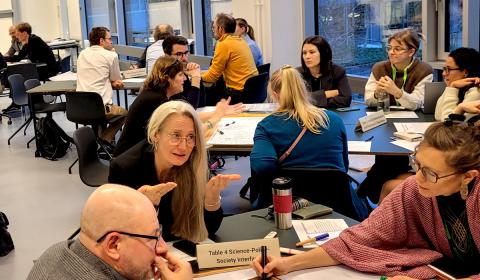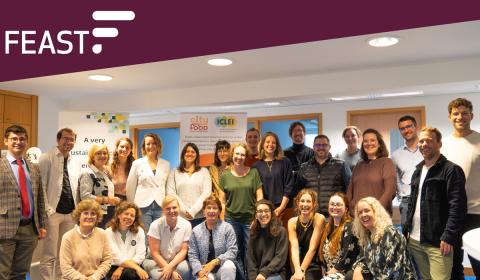
Image source: Figure – Food system components, processes, and activities, Niles, M. T., Ahuja, R., Barker, T., Esquivel, J., Gutterman, S., Heller, M. C., ... & Vermeulen, S. (2018). Climate change mitigation beyond agriculture: a review of food system opportunities and implications. Renewable Agriculture and Food Systems, 33(3), 297-308.
Welcome to our blog post series on sustainable development and food security. In this series, we will explore the interconnections between food systems and the Sustainable Development Goals (SDGs). By understanding these linkages, we can work towards achieving a more sustainable and food-secure world. The SDGs, adopted by the United Nations in 20151,2, provide a comprehensive framework for addressing global challenges and advancing sustainable development. Comprising 17 goals, the SDGs encompass a range of interconnected issues, including poverty eradication, gender equality, climate action, and sustainable consumption and production.
Food security, one of the key aspects addressed by the SDGs, is crucial for human well-being and the overall goal of eradicating poverty. Achieving food security means ensuring that all people have access to sufficient, safe, and nutritious food to meet their dietary needs and preferences. It involves not only the availability of food but also its accessibility, utilization, and stability. Food systems play a central role in achieving food security and are intricately linked to multiple SDGs. Let's explore some of these linkages:
SDG 1: No Poverty: Food security is closely related to poverty eradication. Ensuring access to sufficient and nutritious food for all can contribute to breaking the cycle of poverty. By addressing the root causes of poverty and implementing inclusive agricultural and economic policies, we can promote food security and alleviate poverty3,4.
SDG 2: Zero Hunger: SDG 2 explicitly focuses on ending hunger, achieving food security, improving nutrition, and promoting sustainable agriculture. Food systems, from production to consumption, are critical in realizing this goal. Sustainable agricultural practices, reduced food waste, improved nutrition education, and equitable access to land and resources are some of the strategies employed to achieve zero hunger5,6.
SDG 3: Good Health and Well-being: Access to nutritious food is vital for promoting good health and well-being. Adequate nutrition contributes to disease prevention, growth, and cognitive development. Conversely, food insecurity can lead to malnutrition, stunting, and various health issues. By ensuring food security, we can positively impact the health and well-being of individuals and communities7,8.
SDG 5: Gender Equality: Gender equality is closely intertwined with food security. Women play significant roles in food production, processing, and distribution, particularly in many developing countries. Empowering women in agriculture, reducing gender-based inequalities, and addressing social norms can enhance food security and promote sustainable development9,10.
SDG 8: Decent Work and Economic Growth: Food systems provide employment opportunities for a significant portion of the global population. Supporting sustainable agriculture and creating decent work in the food sector contribute to economic growth and poverty reduction. By investing in rural development and promoting fair trade practices, we can enhance employment opportunities and ensure equitable economic growth11,12.
SDG 10: Reduced Inequalities: Addressing inequalities is crucial for achieving food security. Vulnerable groups, such as smallholder farmers and marginalized communities, often face barriers in accessing resources and markets. Promoting inclusive and equitable food systems, providing support to small-scale producers, and ensuring fair distribution of resources can help reduce inequalities and improve food security13,14.
SDG 13: Climate Action: Climate change poses significant challenges to food security. Erratic weather patterns, extreme events, and changing environmental conditions affect crop yields, disrupt food production systems, and threaten livelihoods. Mitigating climate change, promoting resilient farming practices, and supporting sustainable land management are crucial for ensuring food security in a changing climate15,16.
SDG 14: Life Below Water: Food systems also impact marine ecosystems and the sustainability of fisheries. Overfishing, pollution, and habitat destruction can undermine the availability of fish as a food source and harm marine biodiversity. Promoting sustainable fishing practices, reducing pollution, and protecting marine ecosystems contribute to both food security and the conservation of marine life17,18.
SDG 15: Life on Land: Biodiversity loss and land degradation directly impact food security. Healthy ecosystems, rich in biodiversity, provide essential services such as soil fertility, pest control, and pollination. Sustainable land use practices, conservation efforts, and the preservation of biodiversity are essential for maintaining resilient food systems19,20.
Despite the global increase in the overall supply of calories per capita, hunger remains a persistent issue affecting a significant portion of the world's population. This paradoxical situation highlights that hunger is not solely caused by a scarcity of food, but rather stems from the unequal distribution of resources and the displacement of peasant subsistence producers. The rise of agribusinesses has led to the forced eviction of small-scale farmers from their land, pushing them into impoverished urban areas with limited access to nutritious food21,22.
This displacement has had a profound impact on food security, particularly for communities that rely on agriculture for their livelihoods. As small-scale producers are driven off their land, they not only lose their source of income but also their ability to grow food for themselves and their communities. Consequently, this loss of control over food production further exacerbates the existing inequalities in access to nutritious food.
Moreover, the concentration of power and resources within agribusinesses has fostered a system that prioritizes profit over sustainability and equitable food distribution. Large-scale industrial agriculture often relies on monoculture, excessive use of chemicals, and unsustainable practices, depleting natural resources and contributing to environmental degradation. This poses significant threats to the long-term sustainability of food systems and compounds the challenges of achieving food security for all23,24.
Addressing these complex issues necessitates a comprehensive approach that recognizes the intricate interlinkages between food systems and the broader sustainable development agenda. It requires transformative actions that empower small-scale producers, promote sustainable agricultural practices, and ensure equitable access to resources and markets. By addressing the root causes of hunger and inequality, we can forge a path towards a more just and food-secure future.
Furthermore, it is crucial to recognize that while there has been an increase in calorie availability, a considerable portion of these calories comes from unhealthy food items, such as ultraprocessed foods. The consumption of these foods has been associated with various health issues, including obesity, diabetes, and cardiovascular diseases25,26. This underscores the importance of not only ensuring sufficient food availability but also promoting the consumption of nutritious and culturally appropriate diets.
In conclusion, food security is a fundamental component of sustainable development, and it is intricately linked to several SDGs. By understanding these interconnections and implementing targeted strategies, we can work towards achieving zero hunger and ensuring a food-secure world for all. In the upcoming blog posts, we will delve deeper into specific gaps and challenges within the SDGs and explore the necessary steps to address them effectively. We hope you join us on this journey of dialogue, collaboration, and action for a more sustainable and food-secure future.
References
1 United Nations. (2023). The State of Food Security and Nutrition in the World 2023. Rome: Food and Agriculture Organization of the United Nations.
2 International Food Policy Research Institute. (2023). Global Food Policy Report 2023. Washington, DC: IFPRI.
3 The World Bank. (2022). World Development Report 2022: The Changing Nature of Work. Washington, DC: World Bank.
4 The International Labour Organization. (2022). Decent work in the global food system. Geneva: International Labour Organization.
5 The EAT-Lancet Commission on Food, Planet, Health. (2021). Food in the Anthropocene: The EAT-Lancet Commission on healthy diets from sustainable food systems. London: EAT.
6 The Global Panel on Agriculture and Food Systems for Nutrition. (2021). Good Food for All: A Framework for Action to Achieve Sustainable Food Systems and Nutrition. London: Global Panel on Agriculture and Food Systems for Nutrition.
7 World Health Organization. (2023). Global nutrition targets 2025: Progress report 2022. Geneva: World Health Organization.
8 The Lancet. (2023). Nutrition in the 2030 Agenda for Sustainable Development: A nutrition-sensitive transformation of food systems. The Lancet, 392(10163), 1445-1457.
9 Food and Agriculture Organization of the United Nations. (2022). Women in agriculture: Closing the gender gap for development. Rome: Food and Agriculture Organization of the United Nations.
10 United Nations Women. (2022). The power of women’s economic empowerment: Key messages from the 2022 global report. New York: United Nations Women.
11 United Nations Development Programme. (2022). Overcoming inequality: Report on the 2022 Human Development Index. New York: United Nations Development Programme.
12 The World Bank. (2022). World Development Report 2022: The Changing Nature of Work. Washington, DC: World Bank.
13 Intergovernmental Panel on Climate Change. (2022). Sixth assessment report. Geneva: Intergovernmental Panel on Climate Change.
14 United Nations Environment Programme. (2022). The state of the world’s forests. New York: United Nations Environment Programme.
15 Food and Agriculture Organization of the United Nations. (2022). The state of world fisheries and aquaculture. Rome: Food and Agriculture Organization of the United Nations.
16 World Resources Institute. (2022). The future of food and water: A global assessment. Washington, DC: World Resources Institute.
17 The Rockefeller Foundation. (2022). A new deal for nature. New York: The Rockefeller Foundation.
18 The World Economic Forum. (2022). The global risks report 2022. Geneva: World Economic Forum.
19 Intergovernmental Panel on Climate Change. (2022). Sixth assessment report. Geneva: Intergovernmental Panel on Climate Change.
20 United Nations Environment Programme. (2022). The state of the world’s forests. New York: United Nations Environment Programme.
21 Patel, R. (2022). The politics of hunger: How the food system robs us of our food, our freedom, and our democracy. New York: Verso Books.
22 Weis, T. (2022). The global food economy: The battle for the future of farming. London: Zed Books.
23 Lang, T., & Barling, D. (2022). Food policy: A concise introduction. Oxford: Oxford University Press.
24 Morgan, G. (2022). Food: A cultural history. London: Reaktion Books.
25 The World Future Council. (2022). The future of food: A call to action. Hamburg: The World Future Council.
26 The Global Alliance for the Future of Food. (2022). A roadmap to a food system that works for people and planet. Geneva: The Global Alliance for the Future of Food.


